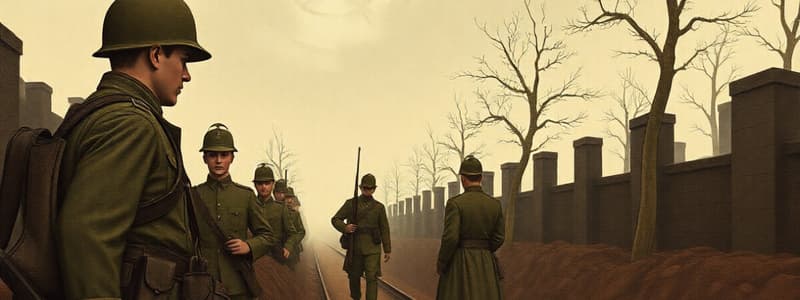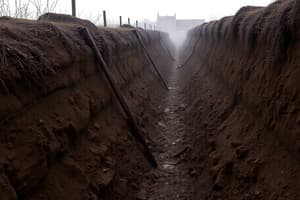Podcast
Questions and Answers
What was a major factor that contributed to the German army's failure to capture Paris?
What was a major factor that contributed to the German army's failure to capture Paris?
- Poor communication within the German ranks
- Delays in mobilizing British forces
- Insufficient supplies for a prolonged campaign
- Rapid mobilization of French troops (correct)
What was primarily used to secure trench positions during winter on the Western Front?
What was primarily used to secure trench positions during winter on the Western Front?
- Machine guns and barbed wire (correct)
- Artillery bombardments
- Tanks and armored vehicles
- Wooden fences
How did the layout of trenches help minimize enemy fire damage?
How did the layout of trenches help minimize enemy fire damage?
- By being open and unobstructed
- By dispersing soldiers along the front
- By creating a zigzag formation (correct)
- By digging them deeper than enemy trenches
Which of the following health issues was prevalent among soldiers in the trenches?
Which of the following health issues was prevalent among soldiers in the trenches?
What psychological condition was commonly experienced by soldiers, often referred to as 'shell-shock'?
What psychological condition was commonly experienced by soldiers, often referred to as 'shell-shock'?
Flashcards
No Man's Land
No Man's Land
The area of land between opposing trenches on the Western Front during World War I. It was heavily fortified with barbed wire and landmines, and was a very dangerous place to be.
Trench Warfare
Trench Warfare
A long, narrow ditch dug by soldiers to protect themselves from enemy fire. They were often lined with barbed wire and machine guns.
Trench Foot
Trench Foot
A condition suffered by soldiers in the trenches during World War I, caused by prolonged exposure to cold, wet, and unsanitary conditions. It could lead to infections, gangrene, and even amputation.
Shell Shock
Shell Shock
Signup and view all the flashcards
Trench Mouth
Trench Mouth
Signup and view all the flashcards
Study Notes
Western Front
- Germany wanted to capture Paris before the Allies could mobilize.
- Allied forces moved faster than expected, using vehicles (taxis, etc.).
- British forces helped halt the German advance at the Marne River.
- The Allies pushed the Germans back to the Aisne River.
- October 1914, both sides fortified their positions with trenches.
Trench Warfare
- Trenches were dug, protected by machine guns and barbed wire.
- Trench lines stretched hundreds of kilometers.
- Trenches extended from the English Channel to the Swiss border.
- Parallel trenches were separated by a 25m "No Man's Land", filled with landmines and barbed wire.
- Trenches were often zig-zagged to prevent enemy fire from sweeping the entire trench line.
- Communication trenches connected various parts of the trench lines.
- Trenches became very unpleasant. Waterlogged, muddy, and unsanitary conditions led to injuries, diseases and death. Causes of death included sickness, injury, disease, and trench foot (rotting flesh).
Conditions in the Trenches
- Trenches were often flooded.
- Soldiers had to deal with cold, wet, and unsanitary conditions.
- This led to the spread of disease and sickness, including trench mouth and body lice.
- Rats and other animals were common in the mud-caked trenches
- Soldiers frequently suffered from stress, shell shock, and other psychological traumas.
Canadian Troops
- In mid-April 1915, a Canadian division of 20,000 men joined the Allied forces on the Western Front.
Studying That Suits You
Use AI to generate personalized quizzes and flashcards to suit your learning preferences.




